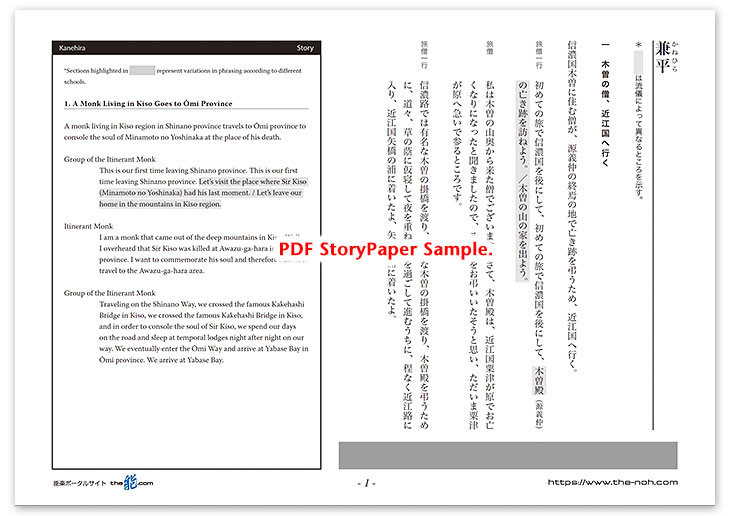
 Kanehira
Kanehira

![]()
A monk from Kiso region travels to Awazu-ga-hara in Ōmi province to make prayers for the repose of the soul of Minamoto no Yoshinaka who was killed there. When the monk arrives at Yabase Bay on Lake Biwa where ferries sail to Awazu-ga-hara, he finds an old man on a boat loaded with bunches of brushwood is rowing towards him. The monk asks the old man to take him to Awazu-ga-hara on his boat. The old man declines his request at first, since this is a cargo boat and not a ferry; however, he reconsiders the decision because this is his opportunity given to meet a monk who has renounced the world. He also remembers a phrase in the Lotus Sutra, “a mercy from the Buddha is like getting a ferry ride at a port in time.” He invites the monk to his boat and sails out to the opposite shore.
On the boat, the monk asks the old man about famous sites in the area. The old man talks about the lofty Mount Hiei and other renowned places. Arriving at Awazu-ga-hara, the monk gets off the boat and meets with a local ferryman who tells the monk about the battle which Kiso (Minamoto) no Yoshinaka had fought together with Imai Shirō Kanehira. After the story, the ferryman, who listened to the monk’s story with the old man, encourages him to hold a memorial service for the old man as he believes it must be the ghost of Kanehira.
The monk holds a memorial service and stays at Awazu-ga-hara for the night. When he is taking a nap, a warrior appears in his dream. The warrior introduces himself as Imai Shirō Kanehira and reveals that the old man on the boat earlier that day was himself. The ghost of Kanehira tells the monk how his master, Kiso no Yoshinaka, faced his last moment and asks him to commemorate Yoshinaka’s soul well, rather than holding a memorial service for himself. Furthermore, the ghost describes the battle scene in Awazu-ga-hara and shows his heroic final moment when he killed himself by holding a sword in his mouth.
![]()
The lead character, Imai Shirō Kanehira, is a warrior who was a vassal to Minamoto (Kiso) no Yoshinaka, who was known as Asahi Shōgun (General Sunrise). Yoshinaka was a cousin of the two brothers Minamoto no Yoritomo and Yoshitsune and he fought well during the war between Heike [Taira] and Genji [Minamoto] clans. Supported by his significant contributions to the war, he once came to power; however, later on he started to fight against Yoritomo. In the end, Yoshinaka lost the fight with his own Minamoto clan against Yoritomo, and died in the battle at Awazu-ga-hara in Ōmi province.
Kanehira was the man who accompanied Yoshinaka until his last moment. Kanehira was a foster brother of Yoshinaka and had a strong bond with his master. Also, it is told that Tomoe Gozen (Lady Tomoe), who is a famous female warrior who served Yoshinaka, was a sister or a niece of Kanehira. In this Noh piece, Kanehira, the language and behavior of the warrior Kanehira is described well, especially in the second half, which indirectly tells us the strong bond between a lord and a vassal at that time in the warrior society.
In ancient Japan, the bond between lord and vassal was a virtue and considered to be respected for three generations, which is stronger than those of a wedded couple and of parent and child. However, in reality, history frequently witnessed betrayals and rebellions of vassals against their masters. Therefore, the loyalty described in Kanehira, that a vassal sacrifices himself for his master until the last moment, stands out as a rare and ideal demeanor for a warrior that was found only in stories. By selecting vassal Kanehira as the lead, instead of his master Yoshinaka, the author might intend to depict the ideal of warrior. It seems Kanehira’s brave way of committing suicide, described at the end of this drama, especially suggests that intention.
STORY PAPER : Kanehira
Story Paper presents noh chant stories in modern speech, with story outlines, highlights and more using Adobe PDF format, which can print out and zoom in. Print out the pages and take them with you when you see the actual noh performance.

The copyright of Story Paper is held by the Noh.com. Story Paper is for individual use only. It is prohibited by the copyright law to distribute or publish printed-out Story Paper pages without prior consent. For more information, check the credit and disclaimer pages.



 [Kanehira : Story Paper PDF : 533KB
[Kanehira : Story Paper PDF : 533KB